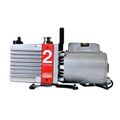Vacuumpomp
| Project Vacuumpomp | |
|---|---|
| Rebuilding a vacuum pump | |
| Status | In progress |
| Contact | thomas |
| Last Update | 2023-12-28 |
Leybold Trivac D8B
We need a roughing pump for our turbos. I bought this unit a while ago, and it works, but it also makes funny noises.
Plan
It needs to be opened up. I may have to fabricate and/or purchase some new parts to get it back to a more usable state.
Teardown / Rebuild
-
Fully disassembled pump module
-
First and second stage vanes
-
First stage vane in pump module segment
-
Original busted gasket and temporary laser cut silicone replacement
-
Freshly polished gasket surfaces of pump main mount and housing
-
Shaft seal driver. This tool makes it harder to screw up when installing new shaft seals.
-
Old gas ballast seal next to its replacement
-
Restored pump module installed
-
It runs!
Lessons learned so far:
- Use fine scotch-brite and q-tips with metal polish (i use German stuff called Gundel-Putz extra-blau) for polishing gasket/critical surfaces. Go easy on the aluminium with the scotch-brite, and the polish will take it to an almost mirror finish. The cast-iron takes a bit more work. My goal was to remove any scratches from the surfaces and vane chambers that stood proud to the point of being detectable by running my nail/fingertip over them, and thankfully there were very few. The same combo of scotch-brite and polish worked here too, it just takes a little longer. Remove as little material as possible! Wipe thoroughly and flush everything with alcohol afterward, paying special attention to remove any possibly abrasive debris, and then apply a thin coat of vacuum oil to protect the parts.
- For those who wish to replace the shaft seals without being extorted by Leybold, they are regular FKM GR 15x24x6.5 SS 304 spring oil seals. Available as a general commodity item.
- Use a special driver to install the new shaft seals. I designed one, you can find the STL here.
- Do not try to replace the gas ballast seal unless absolutely necessary. It is very hard to remove from its deep, blind hole. It also incorporates an internal metal ring, making cutting the seal out impossible. See gallery photo above. It took me three hours to remove it without damaging the seat, with a combination of solvents, a scalpel and a hemostat. Don't be me, leave it be. Reseating the new one is also a major pain in the ass.
- If the vanes seem a bit loose when dry, like they have too much play in the rotor slots and wobble around a bit, don't worry. Once there is an oil film between the vanes and the rotor surfaces, they'll be just fine.
- Find the silencer nozzle on the detailed diagram and unclog that bastard. I am 99% sure this was the cause of the noise that prompted the rebuild. Its job is to inject a tiny bit of air into the second stage vane chamber, to keep it from making excessive noise ("oil slap") when the pump reaches final pressure. The orifice is incredibly small. I used a thread from some stranded wire to unclog it. Be careful though, it is made of aluminium for some reason.
- Reassembling the pump module is both straight-forward and terrifying, thanks to the pin fittings (which took quite some carefully applied force to place). There is really only one order of assembly possible, starting with the segment containing the oil pump and the inner shaft seal. At each assembly step where one segment had to be mounted on another, I first drove the pins through the upper segment, separate from the stack, on a piece of silicone rubber, to where the conical end of the pin protruded slightly through to the other side. This makes it easier to align segments correctly when you place them on the stack and then drive the pins home. I did have one occasion where the pin fittings came loose and a gap appeared between the segments. Very careful tapping with a rubber mallet and protective silicone rubber helped sort this out (i hope). Make sure to lubricate every moving part/surface liberally before closing up as you go along towards the back of the pump module, so that it doesn't run dry during first startup.
Result
The pump reads around 2-3*10^-3 mbar on an MKS-901p transducer, and pretty much bottoms out a DV-23 thermocouple gauge, so it looks like it's back to pumping at factory specs. Oh yeah, and it doesn't leak oil! Not even a little! Rebuild was successful.
Here's a glass ampoule, with atmosphere evacuated to some fraction of standard pressure, then sealed and excited with high frequency/voltage AC:
Edwards E2M2
Pump number two is currently being torn down to assess whether a rebuild is worthwhile. Teardown is not yet complete. Some of the more delicate parts are sitting on a tray in the lounge.
-
E2M2







